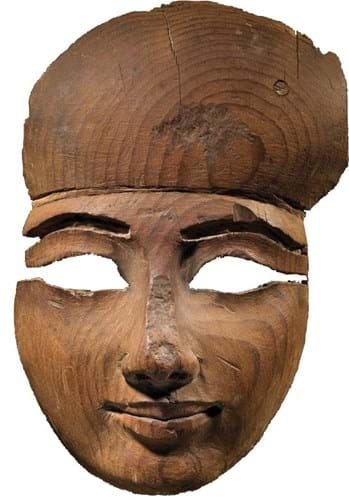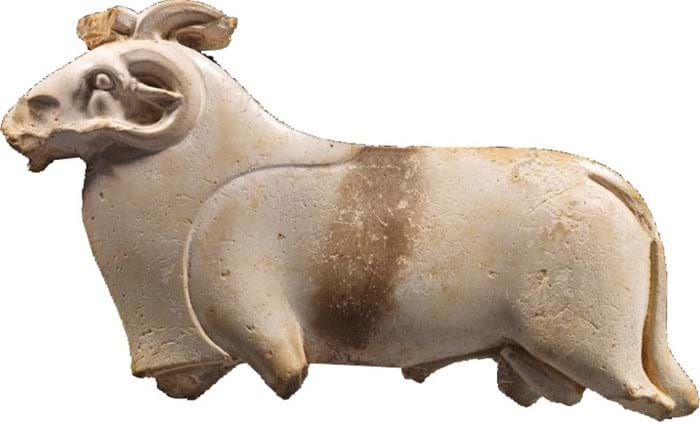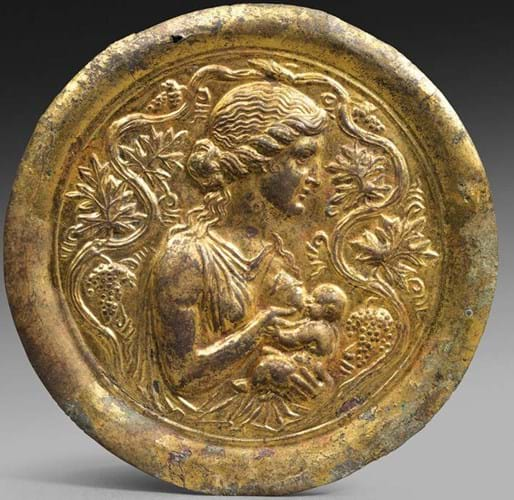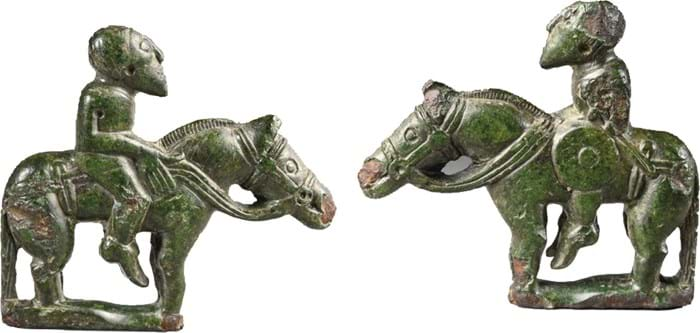
Wood sarcophagus mask, Egyptian, Third Intermediate Period, 22nd Dynasty, 945-730BC, 14in (35cm) tall. It was owned by John Perdios, acquired from Rohayem Antiquaire, Alexandria, Egypt in 1976; then a private collection UK, received as a wedding gift from Perdios in 1982. It sold at Rupert Wace’s summer exhibition where it had a six-figure asking price.
An ancient Egyptian wood sarcophagus mask from the Third Intermediate Period, 22nd Dynasty (945-730BC), was among highlights at Rupert Wace’s summer exhibition.
Offered for a six-figure sum, it was one of 20 sales at the show which marked Wace’s first major foray back into the market since shutting up his west London gallery four years ago.
Staged in Cromwell Place in South Kensington, London, the exhibition also featured works from the Classical world and the Near East.

Ivory-glazed faience inlay of the Amun Ram, Egyptian, Late Dynastic/ Ptolemaic Period, c.712-30BC, 3in (7cm) long, owned by Martine de Béhague, Comtesse R de Béarn (1870-1939), sold during the Rupert Wace summer exhibition where it had an asking price of £15,000.
Another of the stand-out sales was an ivory-glazed faience inlay of the Amun Ram, from the Egyptian Late Dynastic/Ptolemaic Period (c.712- 30BC), formerly in the collection of the Comtesse de Beague (1870- 1939), which was snapped up by a Continental collector. It had an asking price of £15,000.
“Although fewer people came through, the audience was more discerning, and we sold as many pieces as we would expect to sell at an art fair. We even picked up a new collector or two,” Wace tells ATG.

Gilt-bronze mirror with mother and child, Hellenistic, c. 3rd-1st century BC, 4in (10cm) in diameter, UK private collection, acquired 1950s-60s and then by descent, is still available as part of the Rupert Wace summer catalogue for £45,000.
Fairs pressure
Since closing the gallery doors in 2018 he has taken some time to get used to a slower pace, considering his next steps.
He admits that he does not miss what he terms the “relentless treadmill” of international art fairs.
“Because of the challenges in the antiquities market, you have to be so careful about what you buy. But there is a lot of pressure when doing shows to be sourcing new objects constantly because a lot of the same people come to the different fairs,” he says.
Instead, he’s been channelling his energy into various non-commercial projects.
For example, running alongside the summer show at Cromwell Place was a non-selling exhibition of highlights from The Barrow Collection of Celtic metalwork, built up by Wace over many years.
The show comprised 60 highlights such as torcs, brooches and bracelets.
The two events opened with the launch of the book The Celtic Spirit (also the name of the exhibition), written by art historian Nöel Adams and illustrating all 120 pieces from the collection.
Warrior rides in
Meanwhile, highlights from Wace’s personal collection of Harold Carter watercolours and Harry Burton photographs of the excavation of Tutankhamun’s tomb were exhibited in Avoiding Oblivion at Masterpiece.
These will soon be on view again at the Sainsbury Centre in Norwich and then in Newcastle.
He has also contributed The Bradwell Warrior to an exhibition at Aldeburgh Museum.
The small bronze of a mounted warrior is an example of Anglo-Saxon casting in the round. It was discovered by a metal detectorist in 2015 and has been studied and lectured on during the show by archaeologist Angela Care Evans, formerly curator at the British Museum.
“Now I don’t have the physical premises and I do have Beth [Franklin] but not a larger staff. I am delighted to be operating in a different way,” Wace says.
“I’m quite enjoying working on other people’s projects. Next I am involved in a major show coming up in Hildesheim in Germany, again on Tutankhamun and Akhenaten’s Egypt.”
Worked his way up
That doesn’t mean that he’s going to stop trading any time soon.
He started working in the art world at 18 as an auction house porter and has worked as a dealer for 45 years.
“Underneath it all I’m a collector,” he says. “Dealing started as a necessity because of funds – the only way I was able to buy some things was to sell others.”
Wace has an extensive collection, including the stock of the gallery which he bought up when he closed it, but he is still buying.
He acquired the Bradwell Warrior, for example, in late 2020 when it was hammered down at TimeLine Auctions for £95,000 plus fees (ATG No 2470).
As long as there are such treasures to buy, there will have to be pieces to sell too.
















